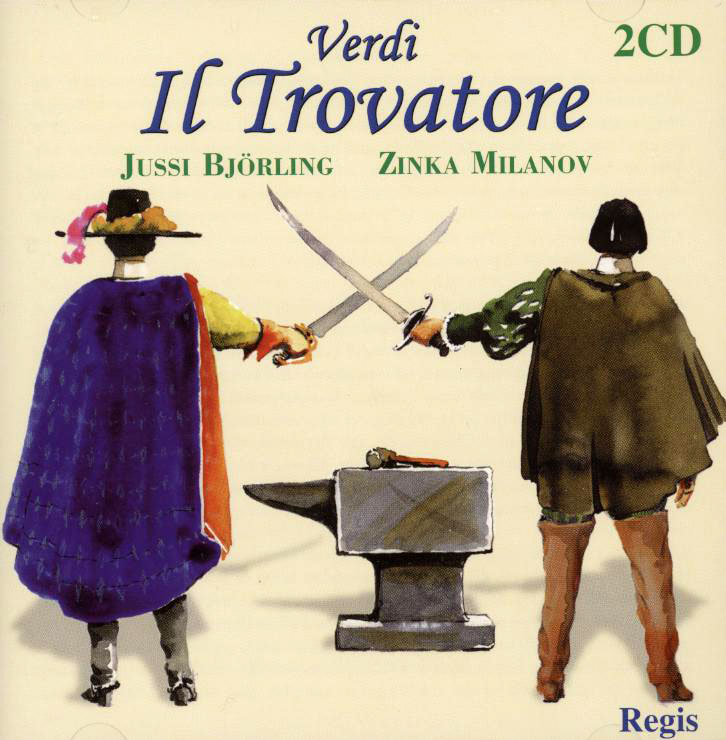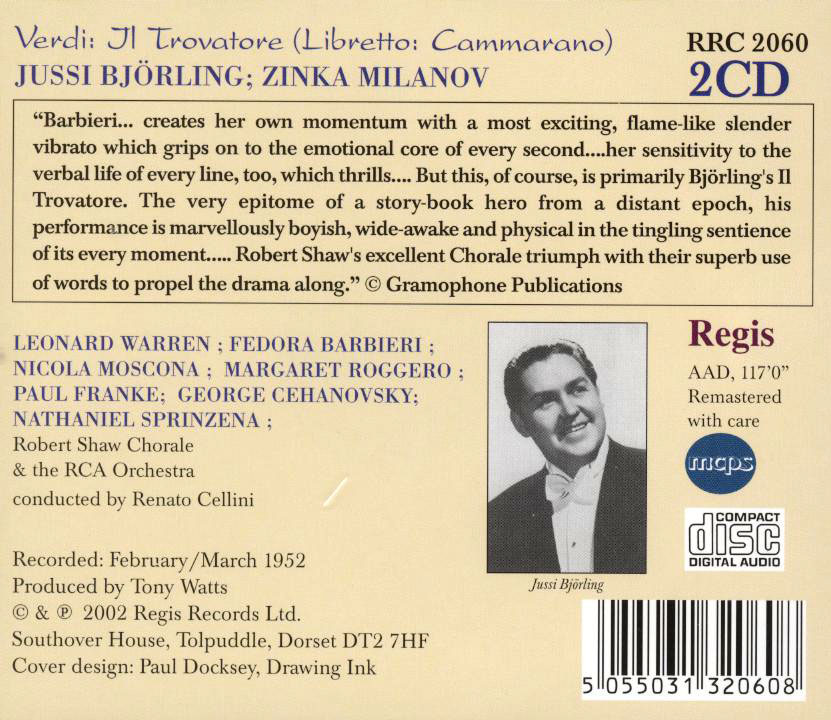Logowanie
Mikołaj - ten to ma gest!
Miles Davis, Horace Silver, Jay Jay Johnson, Percy Heath, Kenny Clarke, Lucky Thompson
Walkin'
20bit K2Super Coding - ale jak to brzmi!
Kasety magnetofonowe
Winylowy niezbędnik
ClearAudio
Double Matrix Professional - Sonic
najbardziej inteligentna i skuteczna pralka do płyt winylowych wszelkiego typu - całkowicie automatyczna
VERDI, Jussi Bjorling, Zinka Milanov, Leonard Warren, Renato Cellini, RCA Victor Orchestra
Il Trovatore

- Jussi Bjorling - tenor
- Zinka Milanov - soprano
- RCA Victor Orchestra - orchestra
- Renato Cellini - conductor
- Leonard Warren - baritone
- VERDI
"..Barbieri..creates her own momentum with a most exciting, flame-like slender vibrato which grips on to the emotional core of every second... Bjorling... epitome of a storybook hero... performance marvellously boyish... tingling sentience of its every moment... Robert Shaw's excellent Chorale..superb use of words.." (Gramophone) 11 Trovatore Verdi's opera Rigoletto which premiered in Venice in March 1851 was a triumph for the 37 year old composer, although censors in various parts of Italy insisted upon changes being made to the setting and to some of the characters' names. Since the huge success of Nabucco nine years previously, Verdi had become the most sought after composer in Italy (Mercadante and Donizetti were to have just one more triumph apiece - Orazi e Curiazi and Don Pasquale respectively and Rossini, long retired as an operatic composer, was resident in Paris). Between 1842 and 1859 Verdi composed twenty operas for a number of different managements. This period, between Nabucco and Un balio in maschera, he referred to as his `anni di galera' (years in the galleys). 11 Trovatore (The Troubadour) of 1852 thus falls midway through this period of `drudgery' and is the centrepiece of his so-called `popular trilogy' (the others being Rigoletto and La Traviata). Considered to be one of Verdi's most tuneful operas, it also however demonstrates his occasional lack of dramatic judgement. The story stems from the Spanish play El trovador by Antonio Garcia Gutierrez, first performed in 1836. Having read this play, Verdi saw possibilities for extending the unconventional style which had become increasingly apparent in Stiffelio (1850) and Rigoletto: fewer static set pieces and consequently a move towards `real time' action. However his chosen librettist, Salvatore Cammarano, had other ideas and delivered to Verdi a text full of strophic songs, conventional duets, trios and choruses. Cammarano, born in 1801, was an experienced writer having worked with Donizetti on a number of operas including Lucia di Lammermoor, Roberto Devereux and Poliuto and had also collaborated with Mercadante in three of his best-known works Orazi e Curiazi, La Vestale and Il Reggente. Verdi had previously used him for Alzira (1845), Luisa Miller and La battaglia di Legnano (both 1849). Cammarano has been heavily criticised for his text for Il Trovatore, but in truth it would have defied the capabilities of the greatest librettist to make sense of the rambling and complex play on which it was based. That Cammarano managed to compress the story into something of manageable proportions was an achievement in itself. Both he and Verdi recognised at an early stage that the key character was that of Azucena and Verdi in particular was able to empathise with her as his own mother died during composition. Verdi also held fixed views as to how the text should proceed, offering much advice to his librettist. He was privately furious when Cammarano failed to answer his letters and, when he did, was disturbed to find that the librettist had ignored Verdi's wishes, leading him to wonder whether he had chosen the right subject and librettist. Three months later, however, in June 1852, both men expressed contentment with the way things were heading. At that time there was no fixed date or venue for the premiere and much hinged on the availability of Verdi's ideal singers. Verdi eventually settled for the Teatro Apollo in Rome and performances were announced for the Carnival season of 1852/3. In July, Verdi was devastated to hear of Cammarano's death and a replacement had to be found quickly to finish the work. A young playwright Leone Emmanuele Bardare was chosen to make some discreet changes, which consisted of enlarging Leonora's role (since the role was to be sung by the company's star performer Rosina Pence) and tightening up certain scenes. The first night on 19 January 1853 was a triumph for all concerned. The public seemed prepared to overlook any shortcomings in the plot and greatly enjoyed the score; so much so that the final scene was encored in full. Before long the work had been given everywhere and its melodies were heard on every street corner. One sign of its success was the proliferation of parodies that came into being on various aspects of the opera and many `alternative' lyrics exist for the Anvil chorus, the Miserere and the Soldier's chorus. Gilbert and Sullivan, notable parodists in their own way, chose the subject of child kidnapping twice in their series of light operas, HMS Pinafore and The Gondoliers (although this may be more due to personal experience on W S Gilbert's part, since he was kidnapped when a child in Italy). Fedora Barbieri (born 1920, Trieste), studied with Giulia Tess and made her debut in Florence at the age of twenty, quickly establishing herself as a leading mezzo in Italy. Her first performance outside Italy was in Buenos Aires in 1947 and in 1950 she made her debuts at both Covent Garden and the Metropolitan Operas. She had an extensive repertory (over 100 roles) and recorded widely, among her most renowned parts being Eboli Don Carlo, Amneris Aida, Azucena Trovatore and the title roles in Carmen and Orfeo ed Euridice. The Swedish tenor Jussi Bjorling, one of the finest and most popular singers on record, was born in 1911. During the 1930s he established a European reputation that became enhanced following his American debut in 1938. His bright, thrilling voice which remained intact throughout a career stretching over thirty years, took well to the microphone and he made many "hit" recordings (see Regis RRC 1080). Sadly he appeared rarely in the UK, the last occasion being a series of Bohemes at Covent Garden in 1960, the year of his death. Leonard Warren, like Bjórling, was born in 1911 and also died in 1960 (1960 was a veritable annus hórribilis for opera lovers, with Lawrence Tibbett and Lucrezia Bori also dying). As Tibbett had displaced Antonio Scotti at the Met, so did Warren replace his compatriot Tibbett, and from the early 1940s until his death during a performance of La forza del destino Warren was a principal attraction there, his huge yet beautifully wellrounded voice and excellent acting being a highlight of many recordings and productions. The Greek bass Nicola Moscona (1907-75) was born Nicolai Mosconas. He made his debut in 1929 but became best known following his Metropolitan Opera debut in 1937 as Ramfis Aida Moscona features on many recordings and was a favourite singer of Arturo Toscanini. Following his long and distinguished career there (25 seasons during which he sang over 30 roles) he became a noted teacher at Philadelphia's Academy of Vocal Arts, one pupil being the bass James Morris. © 2002 James Murray































